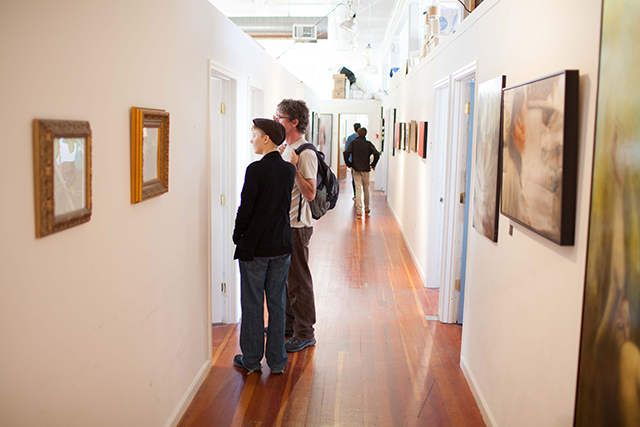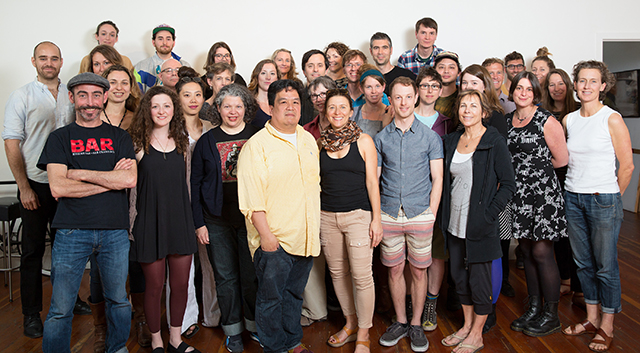Studio 17, a group of over 70 artists in San Francisco’s historic Redlick Building, is facing displacement because their landlord is currently not taking any steps to allow them to renew their lease.
This is a different story than the eviction tale we’re used to, a bit quieter than an invocation of the Ellis Act or suddenly quadrupled rents. The story of Studio 17 involves a lease’s looming end without explicit discussions of renewal. Artists who have worked in the building for years must now choose between leaving for new spaces (if they can find them), or counting down the days till June 30 and facing a sudden – and potentially final – exit from the premises.
The Redlick Building at the corner of 17th and Mission, which houses Thrift Town, Fabric Outlet and a number of small businesses in addition to artist studios, was purchased by Rick Holman, Managing Partner of Asher Insights, Inc., in 2013. Initial fears that the building (once known for its enigmatic “17 Reasons Why!” sign) would turn into condos or evict its tenants were temporarily assuaged by an open letter from Holman in May 2013.
“We have no intention to tear down the building, convert the building to lofts or condos, or otherwise change its fundamental character or use,” he wrote. He pointed to the building’s seismic issues and his desire to make the building safe for its tenants.

On April 15, Studio 17, which occupies most of the building’s fourth floor and some of the third, issued a press release to publicize their state of limbo. “With no word of a lease renewal and no word of our fate in the existing space, I am assuming that we will be displaced at the expiration of our lease,” says artist and Studio 17 member Truong Tran.
Other leases within the building have been renewed, leaving questions as to why Studio 17 is different.
Holman asserts his plans for the building have not changed. “We continue to be committed to provide substantial space to artists in the Mission at a discount to the going market rates. We have recently renewed leases with existing artists in ~6,000 square feet at a substantial discount to market spaces. In May, we plan to meet with and directly negotiate additional new leases with artists for a total of ~20,000 square feet in the building.”
Prominent local photographer Jim Goldberg, one of the “existing artists” with a renewed lease on his Redlick Building studio, says he feels the stress of the Studio 17 situation “all around me.” He also says the changing atmosphere is also palpable: while the top floors of the building were always artists, “everything around them and below them has changed,” he recalls, even down to the smells. Instead of homemade Chinese food in sewing factories, there is now the scent of neighbors’ catered lunches.
Since his initial lease, Goldberg’s rent has increased over 250 percent.
“We can’t afford to move or slow down,” he says, acknowledging he has more space and stability than most of the artists in the building. “I feel lucky for that… but I don’t know how long I can afford to hold out as the rents go up. I am grateful to be able to stay, at least for now. I think about it every day.”
The situation is complicated by differing claims with regards to zoning issues. An original 2003 Conditional Use Authorization allowed “trade shop” use of 10,000 square feet of the building’s top floor, the San Francisco Planning Department’s designation for “art activities.”

Studio 17 currently occupies approximately 21,000 square feet of the Redlick Building. According to Gina Simi, the Planning Department’s Communications Manager, Studio 17 is now part of an active Conditional Use case “to legalize the expansion of the trade shop and also add an Administrative Services Use to this tenant space, as well as the others.”
Administrative Services use is defined as “a non-retail use which provides executive, management, administrative, clerical and other services exclusively to the business community and not to the general public.” This designation would allow greater flexibility for uses within the space beyond art studios.
Holman points out that Robert Donald, master leaseholder of the Studio 17 spaces, already rents some of his space to “not only to artists, but also entrepreneurs, tech firms and other office uses.”
Donald, in turn, has levied a zoning violation claim against Holman that the Planning Department is now investigating. The Homeless Children’s Network (a nonprofit that did not respond to a request for a comment), once occupied a fourth floor space within the Redlick Building that is now rented to PlanGrid, a blueprint app for contractors and architects, bringing the pejorative “tech” into the conversation.
“We became aware of the Plangrid.com lease yesterday,” says Simi, “and are pursuing further enforcement action, as it would have required Planning Department review and approval.”
The Redlick Building is located in the Mission Street Neighborhood Commercial Transit Zoning District, which encourages neighborhood-serving commercial development at street level, allowing “offices and general retail sales at the second story, and in some cases at the third floor and above,” explains Simi.
To compound matters further, the 99-year-old building is due for a major seismic upgrade, which Holman confirmed is “moving forward.” Donald and the other members of Studio 17 are unsure as to whether such upgrades will necessitate their evacuation from the building. A general confusion and lack of definitive dates or answers drives their frustration.
“I would like to know what Mr. Holman’s intentions are as it pertains to the existing studio space,” Tran says. “Will it stay as artists’ studio spaces upon completion of the seismic retrofits? Or will it become high end office spaces?”
Based on the math in his plans for the building’s future, it appears Holman will sign leases for 14,000 square feet of studio space in the coming month. The question of what discounted market rates really look like and just how affordable they are remains. If the members of Studio 17 are able to stay, their space will be cut by one third, their unified lease will likely dissolve and their location within the building may change altogether.
“We are doing our best,” Holman writes, “but understand we cannot satisfy everyone.”
Some members of the studio have already moved out. Those who remain are organizing to make their situation as visible as possible, enlisting the help of Rahel Marsie-Hazen, a PR professional. “Too many artist studios, small businesses, working class people are being ousted from this city and they are leaving silently,” Marsie-Hazen wrote in an email. “In order for the community and policy makers to realize this is an issue, they need to be aware of it.”
Nearly 20 members of Studio 17 will participate in Mission Artists United’s Spring Open Studios on Apr. 18 and 19 in what they are already saying “could be the last opportunity” for the public to visit their collective spaces.
“Many of us came to San Francisco to be part of a community, a community that was open to ideas and diverse ways of thinking,” says Tran. For him, the open studios is a rallying cry and an opportunity for others to show their support: “Support the community and the culture that makes this city so unique and welcoming.”